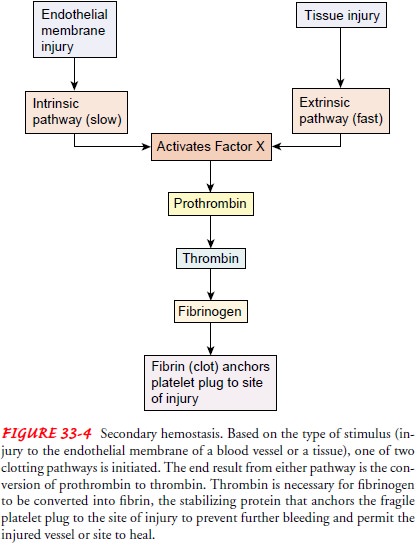Chapter: Medical Surgical Nursing: Assessment and Management of Patients With Hematologic Disorders
Hemostasis
HEMOSTASIS
Hemostasis
is the process of preventing blood loss from intact vessels and of stopping bleeding
from a severed vessel. The pre-vention of blood loss from intact vessels
requires adequate num-bers of functional platelets. Platelets nurture the
endothelium and thereby maintain the structural integrity of the vessel wall.
Two processes are involved in arresting bleeding: primary and secondary
hemostasis.
In
primary hemostasis, the severed blood vessel constricts. Cir-culating platelets
aggregate at the site and adhere to the vessel and to one another. An unstable
hemostatic plug is formed. For the coagulation process to be correctly
activated, circulating inactive coagulation factors must be converted to active
forms. This process occurs on the surface of the aggregated platelets at the
site of vessel injury. The end result is the formation of fibrin, which
reinforces the platelet plug and anchors it to the injury site. This process is
termed secondary hemostasis (Fig. 33-4). The process of blood coagulation is
highly complex. It can be activated by the intrinsic or the extrinsic pathway.
Both pathways are needed for maintenance of normal hemostasis.

Many
factors are involved in the reaction cascade that forms fibrin. When tissue is
injured, the extrinsic pathway is activated by the release from the tissue of a
substance called thromboplastin. As the result of a series of reactions,
prothrombin is converted to thrombin,
which in turn catalyzes the conversion of fibrinogen tofibrin. Clotting by the
intrinsic pathway is activated when the col-lagen that lines blood vessels is
exposed. Clotting factors are acti-vated sequentially until, as with the
extrinsic pathway, fibrin is ultimately formed. Although the intrinsic pathway
is slower, this sequence is probably most often responsible for clotting in
vivo.
As the
injured vessel is repaired and again covered with en-dothelial cells, the
fibrin clot is no longer needed. The fibrin is digested via two systems: the
plasma fibrinolytic system and the cel-lular fibrinolytic system. The substance
plasminogen is required to lyse (break
down) the fibrin. Plasminogen, which is present in all body fluids, circulates
with fibrinogen and is therefore incorpo-rated into the fibrin clot as it
forms. When the clot is no longer needed (eg, after an injured blood vessel has
healed), the plas-minogen is activated to form plasmin. Plasmin actually
digests the fibrinogen, and the breakdown particles of the clot (fibrin
degra-dation products) are released into the circulation. Through this sys-tem,
clots are dissolved as tissue is repaired, and the vascular system returns to
its normal baseline state.
Related Topics